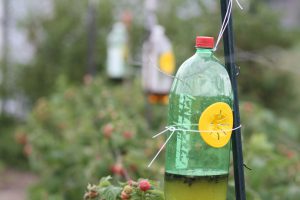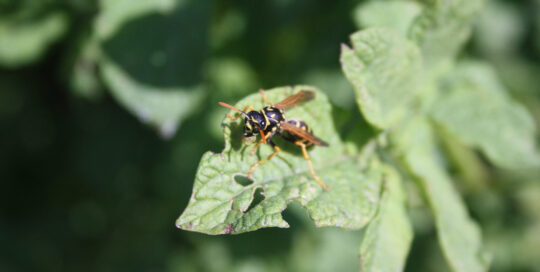The Invasion of the Western Yellowjackets
Views: 6332

I discovered another reason a warm, dry spring isn’t necessarily a good thing: yellowjackets.
It’s not unusual to deal with them at the end of the season, as fruit is ripening and the days are growing short. But this year is different. They started invading a month ago and have been relentless since.
We haven’t been able to eat on the porch most of the summer, and even stepping outside is risky. Our oldest child was stung three times in three days!
The other day I wasn’t thinking. I tossed the empty cantaloupe halves into the chicken coop. When I went in the next morning to give them their food and water, I noticed the melon was absolutely teaming with yellowjackets. I think I went vertical and turned in mid-air. I sprayed the yellowjackets as best as I could with wasp spray, then was able to lift out the melon with a shovel so I could access the coop. Then my husband put the cantaloupe halves near the Shop Vac and sucked up any yellowjackets that came to the fruit over the next couple of days.
The Western Yellowjacket
So we’ve been in a full-on battle with yellowjackets, and this week I spoke to an expert at Montana State University to figure out exactly what we’re dealing with and how to handle them.
After sending her photos, she confirmed that they’re Western yellowjackets, a social wasp with a very bad attitude. The other social wasps we have around here include the aerial yellowjacket, paper wasp, and bald-faced hornet. The big difference between these is the Western yellowjacket is a scavenger that will take what it wants. The other three typically feed on live insects, making them useful in the garden. They also don’t sting for the heck of it. She said 90 percent of yellowjacket stings are from Western yellowjackets.
Preventing Yellowjackets with Traps
The best time to knock down the yellowjacket population is in the spring, by setting up pheromone baited traps, such as WHY Rescue Traps. They work. And if you can get them up early, they’ll potentially catch the mated female before she’s able to produce her evil minions.
This year, we should’ve had them up in April, because it was warm enough for the females to begin to emerge. We’ll stock up on the bait to be ready for next year, that’s for sure.
For now, about the only thing we can do is continually trap the yellowjackets. I don’t know how much good it really does to make an impact on the large population, but at least it feels nice to be able to do something. My husband has been using a variety of traps, including the WHY Rescue ones, and is catching hundreds a day. No sooner does he empty them (after putting them in the freezer to chill the yellowjackets, then dumping them out, and squishing them), that the yellowjackets are filling the trap once again.
Fatal Funnel Traps
My gardening neighbor used another kind of trap, where the yellowjackets drowned in an apple juice concoction. She ordered the plastic entrance discs called Fatal Funnels and put them in 2 liter pop bottles. Inside she put apple juice, sugar, and a little vinegar to hopefully discourage honeybees, although she said it really doesn’t appear that they’re attracted to the Fatal Funnel traps.
The yellowjackets climb inside, tempted by the sweet smell, and quickly drown. If so many yellowjackets stack up inside that they’re walking on the bodies instead of drowning, she just gives the bottle a little swirl. I told her it reminded me of a version of Jonathon Edward’s writing, although this one is, “Yellowjackets in the Hands of an Angry God.”
They obviously work. She has several traps in each of her raspberry beds, and they fill up quickly. She also will take a bucket with water and a little soap along the raspberry patch and flick the individual yellowjackets into their sudsy grave. That’s hardcore… and brave.
It looks like we’re going to be battling yellowjackets until a freeze knocks them out for the season. But I learned a big lesson this year. Don’t simply sit back and enjoy the mild weather if we have another warm spring. Get out there and put up those traps.
Meet Amy Grisak
Amy is a freelance author and photographer in Great Falls, MT who specializes in gardening, foods, and sustainable agriculture. She provides information on every kind…
Amy's Recent Posts

Looking into the Crystal Ball for a Pest Report








